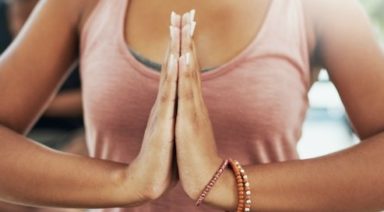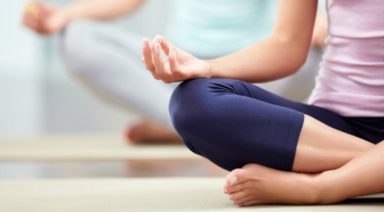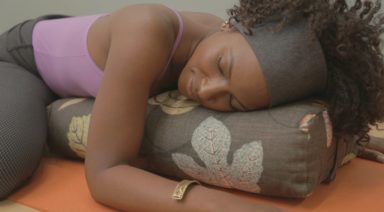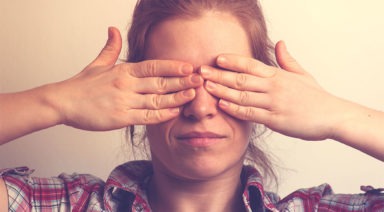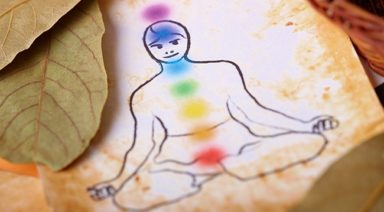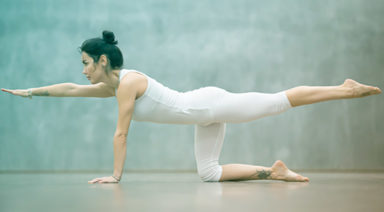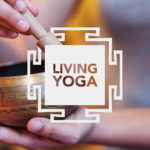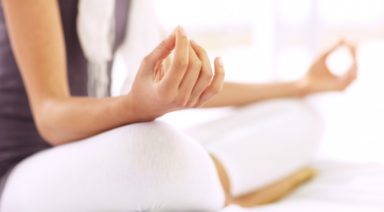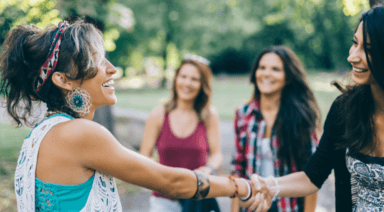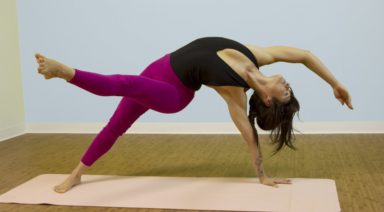10 Tips for Body Confidence in the Bedroom

Whether you’ve been with your partner three times or 300 times, had two dates or 20, getting naked in front of another can be a conflict-ridden experience. Heck, getting naked in front of a mirror can be a conflict-ridden experience. We may try to convince our partner that sex is more intimate with the lights off, or more novel with our dress still on, or that we don’t want to go on top for reasons other than our tummy. Sure, it’s one thing to feel confident in a flattering outfit. It’s another to be confident in lingerie or in the buff. Well, if you’re practicing yoga, you’re off to a good start: Several studies have shown that people who have a regular yoga practice are less likely to struggle with body-image issues and disordered eating; they are less likely to participate in what researchers call self-objectification; and they are more likely to feel connected to and confident with their bodies. So get bendy! And if you’re still feeling shy about rocking your birthday suit in front of your lucky lover, here are 10 more tips for doing it with the lights on:
1. Focus on ability and functionality, rather than appearance. If you’re able-bodied, practice gratitude for that. Think about how incredible it is that we are these biomechanical beings that can bend and run and dance and strut. Now dance and strut!
2. Do number 1. To empowering music. In front of a mirror. Naked.
**3. Three things: Exfoliate, moisturize, bronze. **All-natural and organic, of course. Healthy glow=good. Carcinogens=bad.
4. Find clothes that fit and flatter. Remember, no one can tell what size you’re wearing, but they likely can tell if you’re squeezed into something too small for you. If you anticipate losing weight, you can always get smaller garments in a few months.
**5. Befriend your soft spots. **You have two options: You can despise, detest, and reject your soft spots, your less-than perfect breasts, and your sagging skin; or, you can embrace the imperfections. You change the word “fat” from an adjective to a noun. You can recognize the vital role it plays in your health, comfort, and fertility. You can thank it for allowing you to sit without pain, and you can thank your body for being so efficient at holding onto calories (survival of the fittest! What did you think “fit” meant?). You can smile at your wrinkles, stretch marks, moles and scars, and think about the stories each would tell if it could talk.
6. Let go of expectation and pretend you know what you’re doing. Your partner can only read you from what he or she sees (and as far as they’re concerned, you’re the furthest thing from underconfident). As the saying goes, “Fake it ‘til you make it.”
7. Remind yourself that the models, actors and people in the media who set the standard are not the norm. That is their career. Their income is based on achieving and maintaining a freakishly “perfect” (by western standards) appearance. That is not the rest of the world’s job. It’s probably not your job. So take some of that pressure off. Phew.
8. Anxiety comes from uncertainty. Experience and familiarity builds confidence. Lock the door, turn up the heat, and spend some quality time doing everything in your house/apartment naked. Just make sure the blinds are closed, first, and warn your roommate, or else they might think you’ve lost it. Oh, and maybe avoid opening pickle jars in front your partner in the beginning (Seinfeld, anyone? No?). Want to really dive into your fear? Sign up to be a nude model for an art class. Now THAT’S exposure therapy!
9. Your partner probably isn’t Ryan Gosling (and if he is please ask him why he won’t return my calls). But seriously, they have their imperfections, too. If that doesn’t seem apparent, physically, know that they still have insecurities about parts of themselves, physical, emotional, mental—everyone does. Some are just better at self-acceptance than others.
10. Your lucky partner is pumped to be there. Let me ask you this: When in the history of ever has one partner watched the other disrobe then said, “Sorry. I actually don’t want to have sex with you, now. I expected you to look different underneath your clothes”? My point exactly. If you’ve gotten to the point where you’re going to be naked in front of the privileged other, they’re going to be far more turned off by your distracted attempts to contort yourself into a flattering position or refusal to be anywhere but concealed under several blankets. The hard part’s over! Now have some (safe) fun!
What is Tantra Yoga?
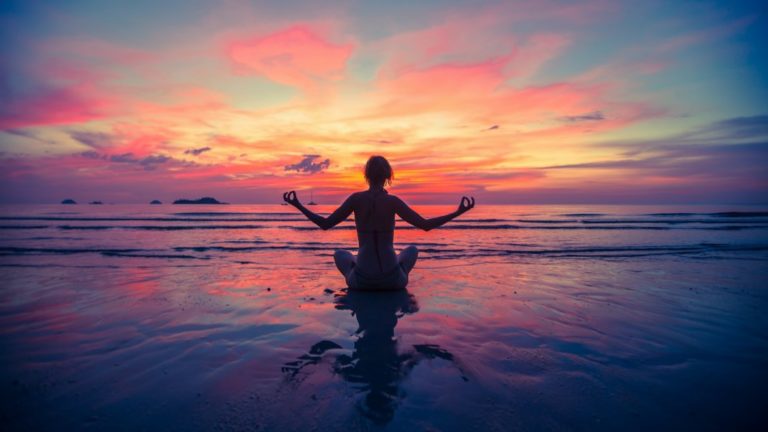
If the word Tantra conjures up scenes of sexuality, you’re not alone. The introduction of Tantric practices in the West has inadvertently become identified with a practice that’s laced with nudity, sexuality, and occasionally, promiscuity.
The truth is, Tantra may enhance your sex life, but only by deepening your connection to your energy and your body first. Although Tantric practices are founded on the principle of intimacy, intimacy is not purely physical. It’s the act of connecting so deeply that you feel as if you are getting a glimpse into your and perhaps another’s soul.
I’ve heard it described as “into me I see” based on the premise that we must gain an awareness of our true selves before we can forge the path of union with others.
What’s the point of Tantra Yoga?
The purpose of Tantra Yoga, is to further emotional wellbeing, aiding spiritual and physical health.
The exploration of the subtle energies within the body and their connection to the universe provide the opportunity to understand the purpose of life and the principles of union in new dimensions.
Rod Stryker, a prominent teacher of Tantra Yoga, describes the intention of Tantra Yoga, “(it) shows us what is blocking us from thriving and offers techniques that will help us attain spiritual and material prosperity.” Hence the goals of the Tantric practices are to enable us to prosper, to thrive and to merge the spiritual world and the material world into one.
What is Tantra Yoga?
The word Tantra means, “to weave or expand.” The root of the word yoga is “yuj” which means, “union.” Similar to some of the other 8 Forms of Yoga, Tantra Yoga blends elements of Raja, Bhakti, Karma, Kundalini, and Hatha practices. What distinguishes it from others is that it also weaves dynamics of other mystical practices as well such as: astrology, Ayurveda, crystals, and gemology to name a few. In utilizing these aspects, the Tantric practice aims to expand beyond perceived limitations of yogic philosophy and the asanas.
The comprehensive approach of Tantra Yoga incorporates conscious breathing practices, pranayama, and meditation, and may be practiced individually or in partnership with another. In both practices, the relationship between the micro (self) and the macro (others) is enhanced.
Vinyasa, as a moving meditation through postures, or asanas, also may be practiced partnering, as a blending of energies or as a sole practitioner. The aim is the same: to gain awareness of our strengths and weaknesses, the places where we resist union with ourselves and others, and cultivate the ability to consciously respond rather than unconsciously react to both our fears and desires. When that occurs, we reach a state of eternal bliss.
Five Tantra Yoga Practices
1. Peace Pose with Pranayam, Conscious Breathing
Begin in a cross-legged seated position, Sukhasana, or peace pose. Gaze down; if knees are higher than hip creases, sit on a yoga block or rolled up yoga mat to elevate the spine.
For solo practice, place hands in gyan mudra (also referred to as jnana mudra in some practices) with the tip of the index finger touching the tip of the thumb, extending out the other three fingers with the palms facing up and resting on knees or thighs. Gyan mudra, a yogic shape for the hands, is considered the prime mudra with many health and grounding benefits.
If practicing with a partner, sit back to back in peace pose, sukhasana. You’ll want to align your spines: start by scooting your seats as close to one another as possible. Option to use prithvi mudra, tips of the ring fingers touching the tips of the thumbs, remaining three fingers outstretched but relaxed. This mudra creates a circuitry igniting the heart meridian, or line of energy that extends from the ring fingers, extends up through the arms and confluences at heart center in both the front and backside of the chest.
Take five full breaths, focusing on smoothing out the length of the inhale to match the same length on the exhale.
2. Sun Salutations, Surya Namaskar
Start in mountain pose (tadasana/urdhva hastasana), standing at the top of your yoga mat. As an individual practice, you may like to practice facing a full-length mirror. In a partner practice, you could either practice facing one another or side by side. Bring palms to meet at heart center in anjali mudra (prayer gesture) or place one hand on your heart, and one on your partner’s heart. Take five deep breaths.
Extend arms overhead, mountain pose, then bow forward, keeping your heart open and gaze forward, and release your head into a forward fold (uttanasana). Bring hands to shins or thighs and lengthen through your spine for a halfway lift (ardha uttanasana). Repeat three times.
3. Modified Side Plank/ Partner Modified Side Plank Pose
Start in table pose, wrists aligned under shoulders, hands spread wide, and hips stacked over knees. For partner modified plank pose, you can lightly touch the crown of the head with one another while in table. Then extend your right shins behind you, toes curled under as you root right hand into the mat and open your chests towards one another.
For an individual practice, bring your left hand to rest over your heart as you stack your left shoulder over right so your heart is wide open. Your hips are also stacked creating a beautiful opening for what are considered our more vulnerable energetic centers: hips and hearts. In partner practice, connect left palms overhead. Enjoy five breaths. Return to table and then switch sides.
4. Partner Peace Pose, Entwined Sukhasana
Come into a loose, cross-legged position (typically the larger person in sukhasana first). Your partner then sits on your thighs and crosses their ankles behind your back. Touch your third eye centers (space between the eyebrows) as you both lengthen through your spines. You may choose to close your eyes or gaze lightly into each other’s eyes as you inhale and exhale through the nose. Take five breaths, allowing a natural synchronicity of breath, with your palms resting on the backside of your partner’s heart. Surrender to the intimate experience of both your and your partner’s heartbeat.
5. Child’s Pose (Balasana), Partner Child’s Pose
Bring your knees wide to the edges of your mat, fold forward resting your forehead on the mat, arms extended overhead but resting on the mat. (If knees are sensitive, you can place the folded edges of a blanket behind your knees before folding forward or rest your seat and perhaps forehead on yoga blocks.) If shoulders allow, bring your palms to touch in prayer, symbolic of union with all aspects of yourself.
For partner child’s pose, assume the same shape described above, with heads pointed towards one another. With arms outstretched, you can place your left palm down, and your palm up to connect with your partner’s palms. It’s said that our hands are an extension of our hearts. Envision your inhale emerging from your left palm, breathing in the essence of your partner, and exhaling through your right palm, sharing your essence with your partner.
For a more advanced practice, presuming both partners have healthy knees and spines, you may like to have one partner (typically the larger partner) stay in child’s pose, and the other, sit facing the opposite direction, on the low back of the partner in child’s pose. Slowly, keeping weight in your feet, begin to lower down, using the support of hands on the mat alongside the bottom partner’s hips. Eventually, lower your spine to align with the partner in child’s pose, and relax arms alongside, or extend your arms overhead, sliding palms underneath your partner’s palms.
Stay in close communication with your partner in child’s pose to ensure that each of the actions feels safe and available in their body.
Expand Your Capacity For Intimacy
If you’re practicing Tantra Yoga on your own or with a partner, you’re expanding your capacity for intimacy and union. With practice, we’re able to get up close and intimate with the beliefs and behaviors that hold us back from the intimacy we desire. In addition, Tantric techniques are provided to evolve beyond these barriers so that each and every one of us may thrive and prosper.



